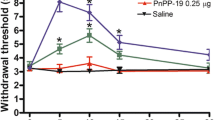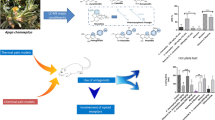Abstract
An ethnopharmacological survey showed that home remedies prepared with flowers and fruits ofPsychotria colorata are used by Amazonian peasants as pain killers. Psychopharmacological in vivo evaluation of alkaloids obtained from leaves and flowers of this species showed a marked dose-dependent naloxone-reversible analgesic activity, therefore suggesting an opioid-like pharmacological profile. This paper reports an inhibitory effect ofP. colorata flower alkaloids on [3H]naloxone binding in rat striata as well as a decrease in adenylate cyclase basal activity. The alkaloids did not affect [3H] GMP-PNP binding. These findings provide a neurochemical basis for the opioid-like activity previously detected in vivo and point toPsychotria alkaloids as a potential source of new bioactive opiate derivatives.
Similar content being viewed by others
References
Mattison, N., Trimble, A. G., and Lasagna, L. 1988. New Drug Development in the United States, 1963 through 1984. Clin. Pharmacol. and Therap. 43(3):290–301.
Miller, R. L., Insel, P. A., and Melnon, L. K. 1978. Inflammatory Disorders. Pages 657–708,in Melnon, L. K. and Morelli, H. F. (eds.), Clinical Pharmacology, Macmillan Publishing Co. Inc., New York.
Flower, R. J., Moncada, S., and Vane, J. R. 1985. Analgesics-Antipyretics and Antiinflamatory Agents, Drugs Employed in the Treatment of Gout. Pages 674–715,in Gilman, A. G., and Goodman, L. S. (eds.), The Pharmacological Basis of Therapeutics, MacMillan Publishing Co. Inc., New York, Chapter 5.
Reid, W. V., Laird, S. A., Gámez, R., Sittenfeld, A., Janzen, D. H., Gollin, M. A., and Juma, C. 1993. A new lease on life. Pages 1–52,in Reid, W. V., Laird, S. A., Gámez, R., Sittenfeld, A., Janzen, D. H., Gollin, M. A., and Juma, C. (eds.), Biodiversity Prospecting: Using Genetic Resources for Sustainable Development, World Resources Institute Publications, Baltimore, Maryland, Chapter 1.
Balandrin, M. F., Klocke, J. A., Wurtele, E. S., and Bollinger, W. H. 1989. Natural plant chemicals: sources of industrial and medicinal materials. Science 228:1154–1160.
Tyler, V. E. 1986. Plant drugs in the twenty-first century. Economic Botany 40:93–103.
Cunningham, A. B. 1993. Ethics, Ethnobiological research and Biodiversity. Page 44,in Lindsay, B. (ed.), WWF International Publications, Gland, Switzerland.
Balick, M. J. 1990. Ethnobotany and the identification of therapeutic agents from the rainforest. Pages (154):22–39,in Chadwick, D. J. and Marsh, J. (eds.), CIBA Foundation Symposium on Bioactive Compounds from Plants. Bangkok, Thailand.
Elisabetsky, E., and Shanley, P. 1994. Ethnopharmacology in the Brazilian Amazon. Pharmacol. Therap., 64:201–214.
Elisabetsky, E., and Castilhos, Z. C. 1990. Plants used as analgesics by Amazonian caboclos as a basis for selecting plants for investigation. Int. J. Crude Drug Res. 28(4):49–60.
Amorozo, M. C. de M., and Gely, A. 1988. Uso de plantas medicinais por caboclos do Baixo Amazonas, Barcarena, PA, Brasil. Boletim do Museu Paraense Emilio Goeldi-Série Botânica 4(1):47–132.
Elisabetsky, E., Amador, T. A., Albuquerque, R. R., Nunes, D. S., and Carvalho, A. C. T. 1995. Analgesic activity ofPsychotria colorata (Will. ex R. & S.) Muell. Arg. (Rubiaceae) alkaloids. J. Ethnopharmacol., in press.
Stein, C. 1993. Peripheral mechanisms of opioid analgesia. Anesth. Analg., 76:182–191.
Olson, G. A., Olson, R. D., and Kastin, A. J. 1993. Endogenous Opiates: 1992. Peptides, 14:1339–1378.
Wollemann, S. B., and Simon, J. 1992. The kappa-opioid receptor: evidence for the different subtypes. Life Sci., 52:599–611.
Birnbaumer, L., Abramowitz, J., and Brown, A. M. 1990. Receptor-effector coupling by G proteins. Bioch. Biophys. Acta. 1031:163–224.
Hepler, J. R., and Gilman, A. G. 1992. G proteins. Trends Pharmacol. Sci., 17:383–387.
Brown, A. M. 1993. Membrane-delimited cell signaling complexes: direct ion channel regulation by G proteins. J. Membrane Biol., 131:93–104.
Jaffe, J. H., and Martin, W. R. 1990. Opioid analgesics and antagonists. Pages 485–521,in Gilman, A. G., Rall, T. W., Nies, A. S. and Taylor, P. (eds.), The Pharmacological Basis of Therapeutics, MacMillan Publishing Co. Inc., New York, Chapter 21.
Carvalho, A. C. T. 1993. Estudo fitoquímico dePsychotria colorata (Will. ex R. S.) M. Arg. utilizando metodologia etnofarmacológica. Belém: Universidade Federal do Pará (Master Thesis), 104p.
Ramabadran, K., Bansinath, M., Turndorf, H. and Puig, M. M. 1989. Tail immersion test for the evaluation of a nociceptive reaction in mice. Methodological considerations. J. Pharmacol. Meth. (21):21–23.
Lee, C., Akera, T., Stolman, S., and Brody, T. M. 1975. Saturable binding of Dihydromorphine and Naloxone to rat brain tissue in vitro. J. Pharmacol. and Exp. Ther. 194(3):583–592.
Souza, D. O., and Ramirez, G. 1991. Effects of guanine nucleotides on kainic acid binding and on adenylate cyclase in chick optic tectum and cerebellum. J. Mol. Neurosci., 3:30–45.
Paz, M. M., Ramos, M., Ramirez, G., and Souza, D. O. (1994). Differential effects of guanine nucleotides on kainic acid binding and on adenylate cyclase activity in chick optic tectum. FEBS Lett. 355:205–208.
Tovey, K. C., Oldham, K. G., and Whelam, J. A. M. 1974. A simple direct assay for cyclic AMP in plasma and other biological samples using an improved competitive protein binding technique. Clin. Chem. Acta. 56:221–234.
Lowry, O. H., Rosebrough, N. J., Farr, A. L., and Randall, R. J. 1951. Protein measurement with the Folin phenol reagent. J. Biol. Chem. 193:265–275.
Grenand, P., Moretti, C., and Jacquemin. 1987. Pages 379–382,in Pharmacopées Taditionnelles en Guyane. I’ORSTOM (ed.), Paris.
Leal, M. B., and Elisabetsky, E. 1995. Opioid-like activity ofPsychotria brachypoda (Muell. Arg.) Britton. Int. J. Pharmacog., in press.
Abbot, F. V. 1988. Peripheral and central antinociception actions of ethylketocyclazocine in the formalin test. Eur. J. of Pharmacol., 152:93–100.
Abbot, F. V., and Young, S. N. 1988. Effect of 5-hydroxytryptamine precursors on morphine analgesia in the formalin test. Pharmacol. Biochem. and Behav., 31(4):855–860.
Sweetnam, P. M., Caldwell, L., Lancaster, J., Bauer, Jr. C., McMillan, B., Kinnier, W. J., and Prince, C. H. 1993. The role of receptor binding in drug discovery. J. Nat. Prod. 56(4):441–455.
Simonds, W. F. 1988. The molecular basis of opioid receptor function. Endocrine Rev. 9(2):200–212.
Leslie, F. M. 1987. Methods used for the study of opioid receptors. Pharmacol. Rev. 39(3):197–249.
Childers, S. R. 1991. Opioid receptor-coupled second messenger systems. Life Sci. 48:1991–2003.
Author information
Authors and Affiliations
Rights and permissions
About this article
Cite this article
Amador, T.A., Elisabetsky, E. & Onofre de Souza, D. Effects ofPsychotria colorata alkaloids in brain opioid system. Neurochem Res 21, 97–102 (1996). https://doi.org/10.1007/BF02527677
Accepted:
Issue Date:
DOI: https://doi.org/10.1007/BF02527677




